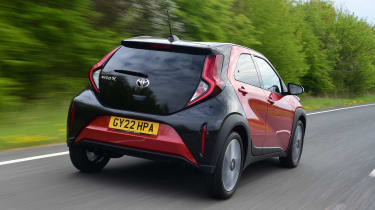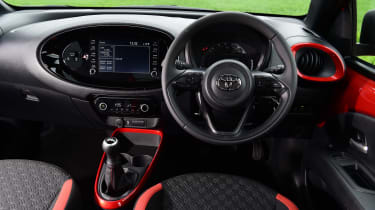New Toyota Aygo X 2022 review
An SUV-inspired makeover sets the latest Aygo apart from its city car rivals, but has it got the X-factor?
Verdict
The Aygo X has taken Toyota’s city car in a new direction. It’s funky and well equipped, which sets it apart from some competitors, even if it isn’t as roomy or as sophisticated to drive – nor as cheap. As a result, you’ll have to really like its new personality, otherwise it’s harder to justify the Aygo X’s position over a range of similarly priced and more grown-up options from the class above.
Toyota’s Aygo X city car has been released at a time when many brands are leaving the segment. So with more opportunity to steal a significant market share, what does Toyota’s latest model offer to make you turn away from the likes of the Volkswagen up! or Hyundai i10.
Unlike its predecessor, which shared tech with its mechanically identical siblings, the Citroen C1 and Peugeot 108, this time the Japanese giant’s city car has gone it alone. To make the most of the brand’s in-house know-how, the Aygo is based on a shortened version of the platform used by the Yaris. The new Aygo is quite a bit longer than its predecessor, however, but at 3.7 metres, it’s still a compact city-focused machine.
It’s not without presence, though. The latest model adopts a pseudo-SUV style, which includes a jacked-up ride height, cartoonishly large wheelarch trims, and 17 or 18-inch alloy wheels depending on spec – quite big considering the car’s size. Throw in the two-tone paint finish and there’s certainly a sense of fun to the design.
The same feeling continues inside. Body-coloured flashes on the doors, around the gearlever and on the dash contrast with the rest of the dark materials and help to make the cabin feel cheerful. It seems much more substantial inside than the old Aygo, too. The previous dash has been replaced with a rounded, sweeping design that houses a touchscreen infotainment system. On top-spec models this measures nine inches, but even the smaller seven and eight-inch displays on lower trims still have Android Auto and Apple CarPlay compatibility.
More reviews
Car group tests
- Toyota Aygo vs Kia Picanto: a used cheap city car shootout
- Hyundai i10 vs Toyota Aygo vs Kia Picanto
- Suzuki Celerio vs Toyota Aygo & Skoda Citigo
In-depth reviews
Road tests
Used car tests
Being so tiny on the outside, it’d be wrong to expect too much space for people and their stuff; even so, compared with rivals such as the Hyundai i10, both head and kneeroom are a little cramped in the back. The rear bench is strictly for two people, but on the plus side, there’s plenty of foot room beneath the front seats. Getting in is a little awkward, because the back doors are small – worth bearing in mind if you plan to fit a bulky child seat. The 231-litre boot is right on the money with the Hyundai, though.
On the road, the Aygo doesn’t quite live up to the promise that we’d hoped for given its close relationship with the Yaris. There are good points; the steering is light and well weighted, which means that it’s both easy to use around town yet not nervous at higher speeds. It’s an agile car, too, which makes it fairly fun to drive in built-up areas.
Those funky-looking wheels harm the ride comfort, though. The Aygo X can feel quite bouncy and unsettled across surfaces where the i10 or up! do quite an impressive job of smoothing bumps out.
But if there’s one area that ages the Aygo, it’s the powertrain. The platform may be shared with the Yaris, but the frugal hybrid powertrain hasn’t made the transition in a bid to keep costs down. In its place is a 1.0-litre three-cylinder petrol engine. When it’s idling, it produces a pronounced vibration that shakes through the cabin. This calms down with more revs, but there are smoother, more refined options in this segment.
With 71bhp, there’s a reasonable amount of performance, but there are times it can be found wanting, although many of these issues are down to the gearbox. The lower ratios are quite long given the power available – 60mph is possible in second – and it means you need lots of revs and to slip the clutch to move off without stalling. While the low gears are long, fifth is relatively short, so the Aygo X is still busy on the motorway. But the shift itself feels slick.
Prices start from £14,805 for the entry-level Pure trim, which gets 17-inch wheels, a seven-inch touchscreen, adaptive cruise control and a reversing camera as standard. For that money, you can buy an i10 with a more powerful 83bhp four-cylinder petrol engine, and with an eight-inch touchscreen. If you’d rather fewer thrills, the Hyundai’s starting price is more than £2,000 cheaper.
The Edge adds larger wheels, automatic air-con and front foglights for £16,505, while the Exclusive trim we tested gains LED headlights, parking sensors all round and wireless phone charging for £17,725. The high-spec Limited Edition adds a retractable canvas sunroof, heated front seats, rear privacy glass and keyless entry and go. But it costs £19,650, nearly a grand more than a Renault Clio, which is more refined, more spacious, more powerful and available with zero per cent finance on a two-year deal.
| Model: | Toyota Aygo X Exclusive |
| Price: | £17,725 |
| Engine: | 1.0-litre 3cyl petrol |
| Power/torque: | 71bhp/93Nm |
| Transmission: | Five-speed manual, front-wheel drive |
| 0-62mph: | 14.9 seconds |
| Top speed: | 98mph |
| Economy: | 56.4mpg |
| CO2: | 110g/km |
| On sale: | Now |






